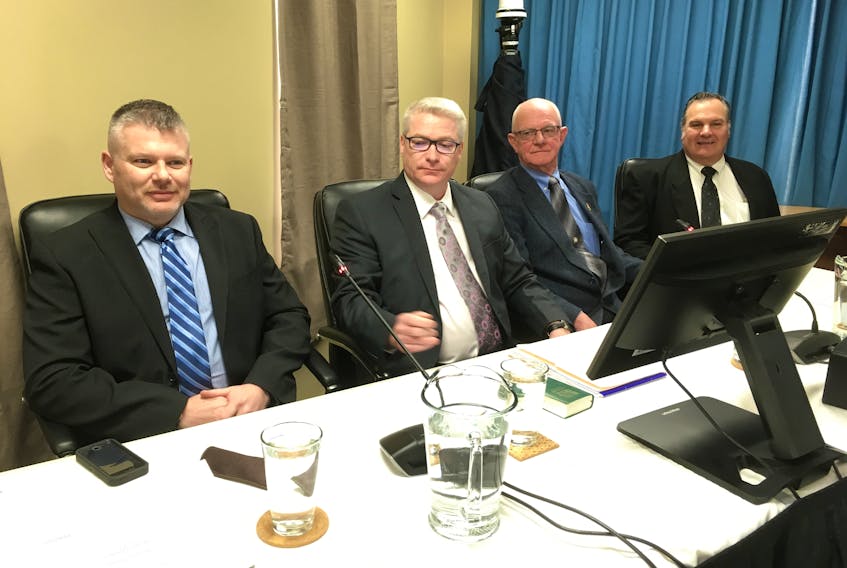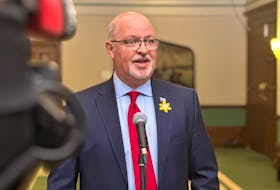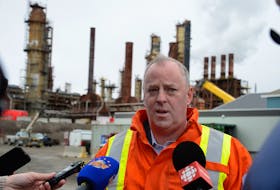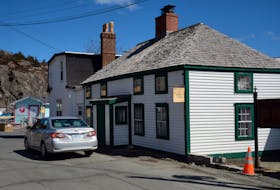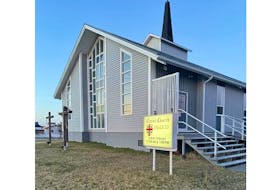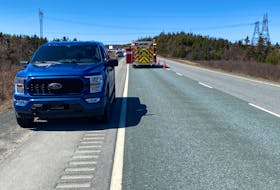ST. JOHN'S, N.L. — Four men who worked on the Muskrat Falls Project appeared together as a “workers’ panel” at the Muskrat Falls Inquiry on Friday. They described the project as far from world-class, particularly through 2014.
Electrician Ken White (now retired) worked at Muskrat Falls until taking a job on the Hebron project in 2015. At Muskrat Falls, he said, there were simple things that developed into real problems.
As an example, he said trailers that acted as change rooms and lunchrooms were often moved around during the day. A worker could start their day, then break, and not be able to find their lunchroom because the trailer had been moved.
There were issues of foresight.
“Basically, we operated not knowing what our expectations were for the next day,” he said, adding it was common for workers to find out late into a shift they were going to be asked to do overtime. He called it a morale killer.
Carpenter Larry Cavaliere, who is still working on the project, said he found it particularly disorganized early on, beginning in the winter of 2013-14, with a mass of workers arriving at the main construction site before the concrete work they were needed for could begin.
The “integrated cover system” that was supposed to protect tradespeople from the elements while working on the powerhouse was never completed. And he said he found a constant pressure to get work completed at a schedule he considered unrealistic from the start.
“There’s a lot of work that could have been done right the first time, and it wasn’t,” he said, blaming the do-overs on disorganization and the rush to make lost milestones.
He said workers were often unaware of what was expected to be put on their plate next.
Members of the panel, including Cavaliere, suggested safety suffered, although Cavaliere also accused Nalcor and Astaldi of “over-management” at times.
“We lost a 40-tonne beam, nobody got hurt. We lost some roof trusses, nobody got hurt. We dropped a crane, nobody got hurt. We lost a draft tube, nobody got hurt. We lost a rebar cage, nobody got hurt,” he said, describing safety incidents sometimes known to the public, but sometimes not.
Quality assurance experts Ed Knox and Perry Snook were with White and Cavalier. The entire group spoke about inappropriate hiring. The workers testified there has been “name hiring” on the project, and nepotism into the management level.
Knox described people coming onto site with junior titles, but “common last names” and quickly becoming supervisors. If a worker pointed it out as a potentially inappropriate appointment, they “were kind of put on the list,” he said.
Cavaliere talked about general foremen handpicking hires from their own family, and workers advancing to more senior roles because of who, and not what, they know.
White called it a “toxic” work environment before his departure.
Snook criticized what he considered to be a lack of focus on quality.
He shared two examples of cases where he believes procurement was also mishandled, including the shipping of turbines to the site, where he said Nalcor was not prepared to properly store them, while the project was behind schedule and installation delayed.
White did take a moment to give credit to Nalcor Energy — for the quality of the workers’ camp.
“Anything you needed was in the camp and it was quite comfortable,” he said, in one of the few positive nods to management.
Before posing some questions to the panel, lawyer for Astaldi Canada Paul Burgess noted to Commissioner Richard LeBlanc that he had made a point to not interrupt throughout the day to statements he felt could be challenged, including hearsay.
LeBlanc said he would weight all evidence appropriately, before Burgess went on to challenge panel members. He made a point to note Knox was in a legal fight with Astaldi over wages, while Cavaliere had been dismissed from a supervisory position during a probation period, before continuing as a carpenter.
Nalcor Energy lawyer Dan Simmons made a point to clarify roles and responsibilities of the workers, noting some of the limits to their individual roles and responsibilities.
Before the day’s testimony began, inquiry co-counsel Kate O’Brien acknowledged there were no women and no Indigenous persons on the panel. She said inquiry counsel was limited to individuals who came forward and agreed to testify. But also, she said the four men on the panel were chosen given their extensive work experience and reach into different areas of the Muskrat Falls Project.
RELATED STORIES:
The Muskrat Falls Inquiry (Phase II)

